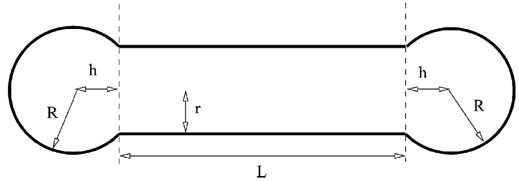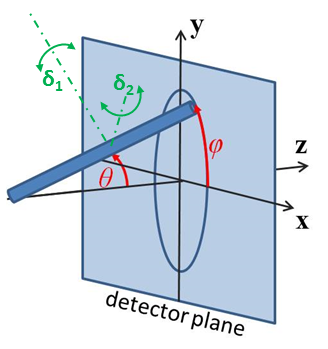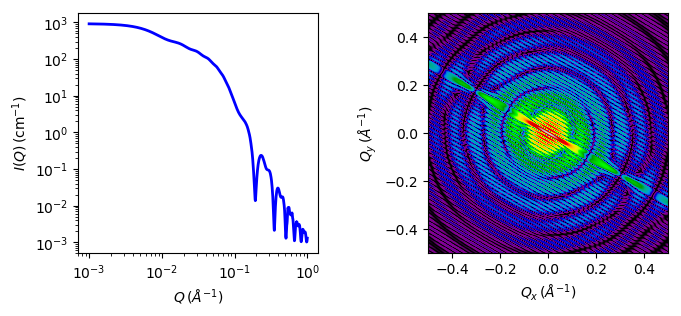barbell¶
Cylinder with spherical end caps
Parameter |
Description |
Units |
Default value |
|---|---|---|---|
scale |
Scale factor or Volume fraction |
None |
1 |
background |
Source background |
cm-1 |
0.001 |
sld |
Barbell scattering length density |
10-6Å-2 |
4 |
sld_solvent |
Solvent scattering length density |
10-6Å-2 |
1 |
radius_bell |
Spherical bell radius |
Å |
40 |
radius |
Cylindrical bar radius |
Å |
20 |
length |
Cylinder bar length |
Å |
400 |
theta |
Barbell axis to beam angle |
degree |
60 |
phi |
Rotation about beam |
degree |
60 |
The returned value is scaled to units of cm-1 sr-1, absolute scale.
Definition
Calculates the scattering from a barbell-shaped cylinder. Like capped_cylinder, this is a spherocylinder with spherical end caps that have a radius larger than that of the cylinder, but with the center of the end cap radius lying outside of the cylinder. See the diagram for the details of the geometry and restrictions on parameter values.

Fig. 1 Barbell geometry, where \(r\) is radius, \(R\) is radius_bell and \(L\) is length. Since the end cap radius \(R \geq r\) and by definition for this geometry \(h \ge 0\), \(h\) is then defined by \(r\) and \(R\) as \(h = \sqrt{R^2 - r^2}\)¶
The scattered intensity \(I(q)\) is calculated as
where the amplitude \(A(q,\alpha)\) with the rod axis at angle \(\alpha\) to \(q\) is given as
The \(\left<\ldots\right>\) brackets denote an average of the structure over all orientations. \(\left<A^2(q,\alpha)\right>\) is then the form factor, \(P(q)\). The scale factor is equivalent to the volume fraction of cylinders, each of volume, \(V\). Contrast \(\Delta\rho\) is the difference of scattering length densities of the cylinder and the surrounding solvent.
The volume of the barbell is
and its radius of gyration is
Note
The requirement that \(R \geq r\) is not enforced in the model! It is up to you to restrict this during analysis.
The 2D scattering intensity is calculated similar to the 2D cylinder model.

Fig. 2 Definition of the angles for oriented 2D barbells.¶

Fig. 3 1D and 2D plots corresponding to the default parameters of the model.¶
Source
barbell.py
\(\ \star\ \) barbell.c
\(\ \star\ \) gauss76.c
\(\ \star\ \) sas_J1.c
\(\ \star\ \) polevl.c
References
H Kaya, J. Appl. Cryst., 37 (2004) 223-230
H Kaya and N R deSouza, J. Appl. Cryst., 37 (2004) 508-509 (addenda and errata)
Onsager, Ann. New York Acad. Sci., 51 (1949) 627-659
Authorship and Verification
Author: NIST IGOR/DANSE Date: pre 2010
Last Modified by: Paul Butler Date: March 20, 2016
Last Reviewed by: Richard Heenan Date: January 4, 2017